A Burnt Grilled Cheese and the Collapse of Indoor Air Quality
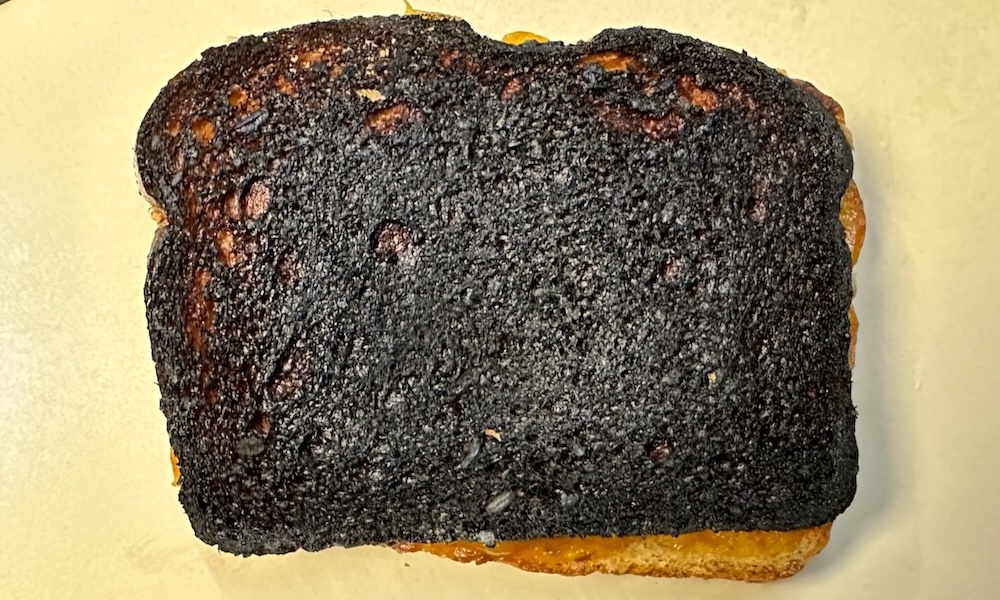
I burned a grilled cheese sandwich recently. I tried to bury the evidence by throwing it in the trash and forgetting about it, but my dear, sweet wife fished it out. “You need to tell the world about this,” she said. “This would be a great blog article to show your readers how something like this affects indoor air quality.” So here you go. I’m going to take responsibility for this burnt grilled cheese and the—blessedly temporary—collapse of indoor air quality in our home that evening. And I’ll also confess to an even worse collapse earlier this year.
Particles galore
The first indoor air quality (IAQ) monitors I used to determine that something was wrong were my eyes and nose. It didn’t smell right, and I got a bit of smoke in the house. So that led me to look at electronic IAQ monitors. Here’s what the Awair Element showed.
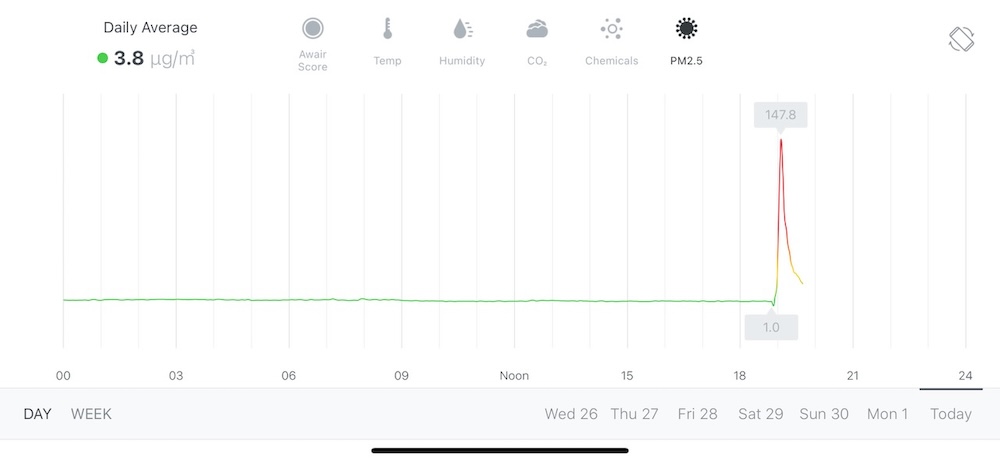
That spike of nearly 150 micrograms per cubic meter (µg/m^3) in the particulate matter 2.5 micrometers (microns) or smaller, usually called PM2.5, is way higher that any other PM2.5 reading I saw that day.
Then I looked at my Airthings Space Plus IAQ monitor (shown below). It showed an even higher spike in PM2.5, this time at 193 µg/m^3. The PM1 (1 micron or smaller), as you see below, also spiked.
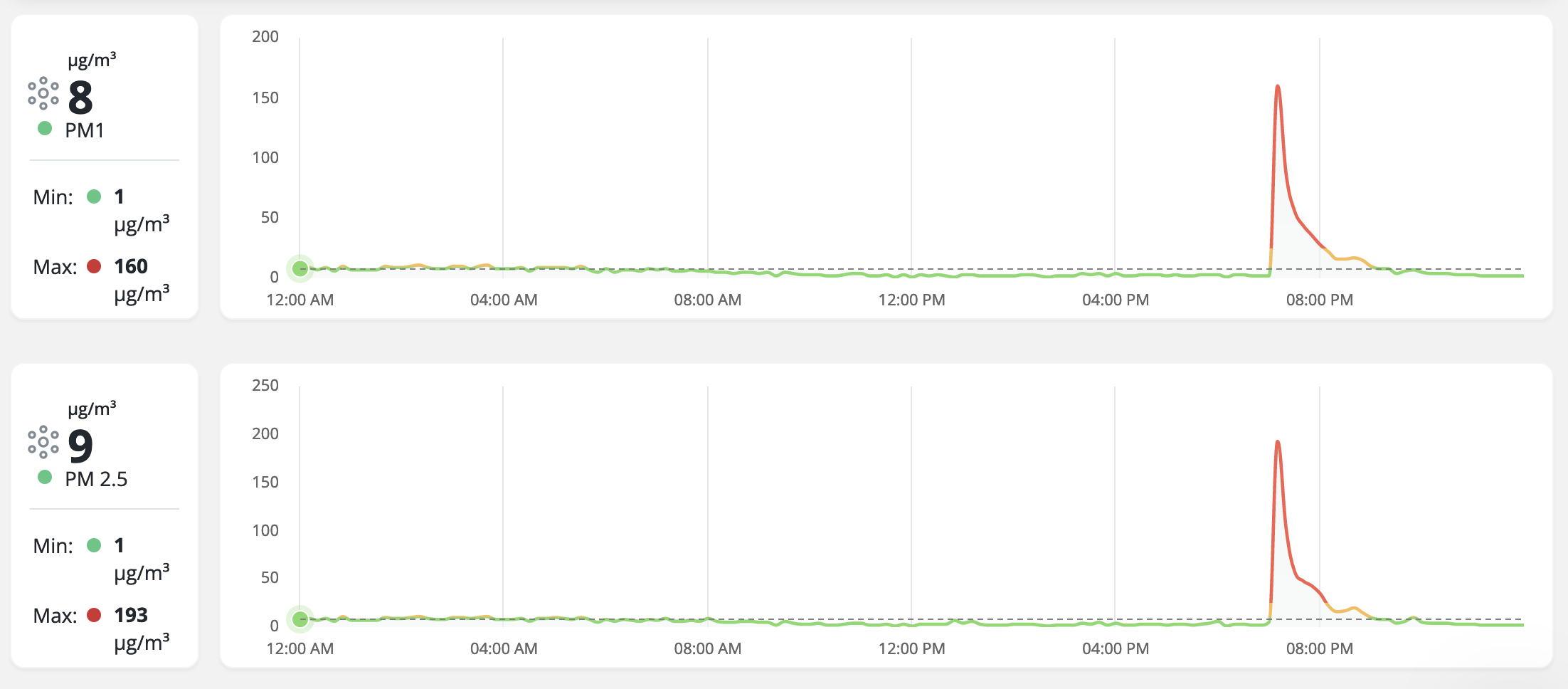
Comparing this spike to average particulate levels
So how does that compare to what the particulate levels usually are in my house? The graph below shows the particulate levels in two size ranges (2.5 microns and 1 micron) for the six months leading up to my burnt grilled cheese catastrophe. The highest PM2.5 peak on there is about 40 µg/m^3.
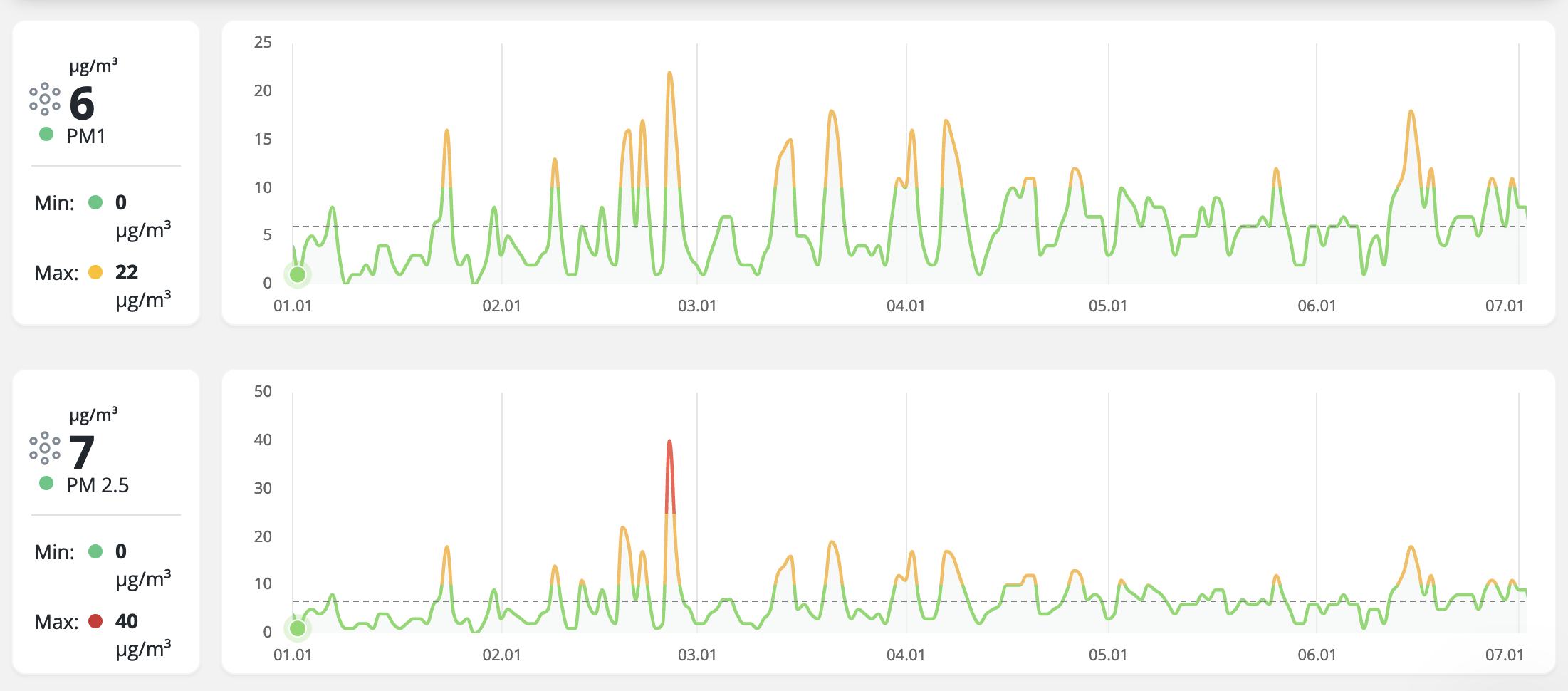
But there’s a catch here. When you look at more than one day, you’re not seeing the full height of the short-term peaks. Let’s look closer at that red spike in PM2.5 that occurred back in February. It’s at 40 µg/m^3. But that’s the average for that whole day. Here’s what it looks like when I zoom in on what happened only on that day.

Holy moly! We hit 869 µg/m^3 during the worst part of that day. What the heck happened? Here’s what it was:
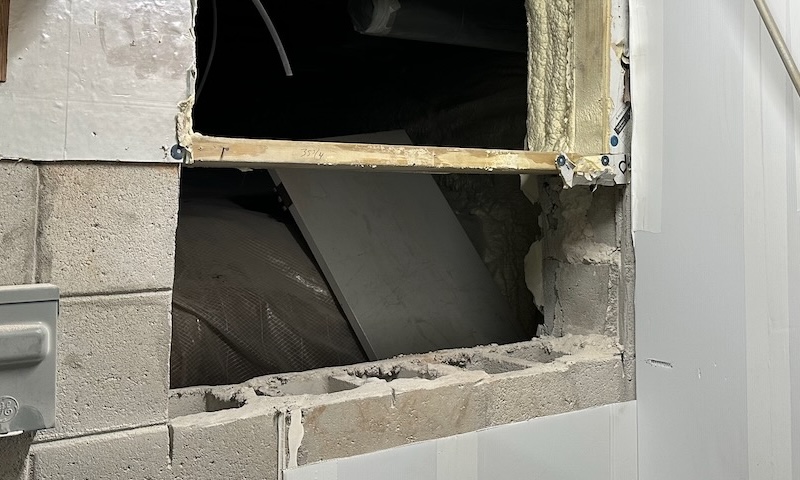
That’s the opening from the mechanical room in our basement to the (encapsulated) crawl space. That board floating in the middle started its day resting on top of the two rows of concrete blocks that were removed in the afternoon.
This was part of the demolition in our basement as we began the renovation that month. The contractor also cut open the concrete slab to pour a new footing. They did both jobs with a gasoline-powered saw that spewed fumes and concrete dust throughout the basement. Even with the exhaust fans running and plastic barriers trying to isolate the basement, a lot of particles made their way into the living space above.
And no, I was not happy when I walked into the basement and saw the cloud of smoke and dust hanging in the air.
How quickly can you remove the particles?
In the case of my burnt grilled cheese, the PM2.5 came down to normal levels (less than 10 µg/m^3) in about two hours. The Airthings graph below shows the big peak of 193 µg/m^3 happened at 7:10 pm that day. At 9:10 pm, the PM2.5 was down to 8 µg/m^3.

It took about 14 hours for the PM2.5 levels during the February spike to come down to less than 10 µg/m^3 again. It stayed in the 20s most of the night.
To get the levels down as quickly as possible, you need filtration and ventilation. In our case, we have three MERV-13 filters in our heating and cooling system on the main floor. In the basement, we have exhaust ventilation that was running continuously during the February event. And we have a Corsi-Rosenthal box fan air cleaner that’s been running continuously in our basement since we began the renovation.
On top of that, when something like this happens, you can turn on other exhaust fans in the house to remove the pollutants more quickly. I’m pretty sure we did that in February. I know we did it for my burnt grilled cheese.
The health risks of fine and ultrafine particles
The particles that make up PM2.5 are also called fine particles. The really tiny ones that are 0.1 microns or smaller are called ultrafine particles. (See my article on PM2.5.) The problem with particles this small is that they can penetrate deep into your lungs. From there, they can get into your bloodstream.
The National Academies (Sciences, Engineering, Medicine) came out earlier this year with a thorough report on what IAQ researchers have found out about particulate matter. It’s called Health Risks of Indoor Exposure to Fine Particulate Matter and Practical Mitigation Solutions, and you can download it for free.
Chapter 6 is all about the health effects of exposure to particles. There’s a lot in there, but here’s the first paragraph of their conclusions in that chapter:
While the literature varies in scope and depth, overall the committee concludes that there is strong evidence that exposure to indoor PM2.5 has adverse effects on the respiratory and cardiovascular systems and likely other organ systems. Specifically, the epidemiologic evidence points to consistent dose–response relationships between indoor PM2.5 exposure and respiratory and cardiovascular outcomes, and this evidence combined with toxicologic evidence and bolstered by the vast outdoor PM2.5 literature directly implicates indoor PM2.5 as a cause of adverse respiratory and cardiovascular effects. Furthermore, evidence for a role of indoor PM2.5 in neurologic, metabolic, and reproductive outcomes is less well developed but emerging. The absence of evidence should not be interpreted as indoor PM2.5 not exerting adverse effects on other organ systems, and instead this gap in knowledge underscores the urgent need for more research. It can thus be concluded reducing PM2.5 exposure would have a significant public health benefit.
Advice for better IAQ
Reducing the particulate matter in your indoor air is a good thing. I’ve mentioned some of the ways to remove it already (ventilation and filtration), but of course the first measure you should take is to try to keep them out of your home in the first place. That’s source control, which is the first step in a layered approach to indoor air quality. You know: Don’t burn the grilled cheese. Don’t run gasoline-powered equipment inside your home if there are other options. Or, as Joe Lstiburek says, just don’t do stupid stuff.
When the particle count goes through the roof as it has at our house this year, throw as much ventilation and filtration as you can at it. Keep that PM low, and you’ll breathe easier.
Allison A. Bailes III, PhD is a speaker, writer, building science consultant, and the founder of Energy Vanguard in Decatur, Georgia. He has a doctorate in physics and is the author of a bestselling book on building science. He also writes the Energy Vanguard Blog. For more updates, you can follow Allison on LinkedIn and subscribe to Energy Vanguard’s weekly newsletter and YouTube channel.
Related Articles
A Layered Approach to Indoor Air Quality
A Vivid Look at the Effects of Air Pollution
Comments are welcome and moderated. Your comment will appear below after approval.

Had a similar experience when repainting my gas log enclosure front (yes, it is sealed, uses outside air for combustion and is vented outside) since it got scraped during construction. I had doors and windows open, and vent fans running as I used the high-heat engine paint to touch up (the doors were painted outside). Regardless, my Awair device’s VOC levels went through the roof! Like yours, the levels quickly recovered to a more normal range.
Norman: It sure is nice to have these consumer-grade IAQ monitors available. The actual numbers don’t matter as much as the trends, so you can monitor an event, like high VOCs in your case, and take appropriate measures until the indoor air has improved. I’ve been modulating my basement exhaust fan use a lot this summer because the more I run it, the more heat and humidity I bring indoors.
Mikita makes a contractor grade 14 inch concrete saw powered by two 40 volt batteries 🤔🤷
https://www.homedepot.com/p/Makita-80V-max-40V-max-X2-XGT-Brushless-Cordless-14-in-Power-Cutter-Kit-8-0Ah-GEC01PL/322342179
Who did the containment and negative air pressure? It seems from your description of both the results upstairs, and the cloud in the basement that it wasn’t adequate.
I have experienced similar short term results with “catastrophic” events like cooking issues! EVERY time my wife cooks something without first turning on the kitchen range exhaust the CO2 and particulate goes into the red zone!
Tim: We began with asbestos remediation, and they set up the plastic barrier to separate the work zone from the rest of the house. We left it in place and I kept my exhaust fan going when they were done, and we added more fans as needed. But yeah, it definitely wasn’t adequate on 26 Feb.
That National Academies report is amazing, I’ve been reading it all morning! You are going to have to add a caveat to your Naked People Need Building Science post:
“Activities that were found to lead to high exposure to resuspended and shed particles were those that involved vigorous movement and those that disturbed dust reservoirs present on furniture and textiles, such as walking, dancing, dusting, folding clothes, making a bed, jumping on the bed.”
No more jumping on the bed!
Please write about or tell me where you have commented on the two subjects below:
1. Cross bracing between floor joists. My 20 year old house does not have braces or blocking. When bought the house two years ago the inspector suggested installation. This single story ranch of 1450 square feet over a full unfinished basement feels solid not live
2. Before adding ( or not) those braces or blocks i would like your ideas about adding insulation below the floor The house has uninsulated metal ducts carrying forced air to floor registers. The same inspector advised that this set up is fine and protected the basement
Which IAQ monitor would you recommend?
Great article! It’s very good to see more definitive research on IAQ (I need to thoroughly read the report to see if any study of exposure duration was included), as well as more affordable IAQ monitoring equipment (just wish it would become a standard part of every home, not just a thermometer/thermostat).
This study, your experience (and the experience of many others) as well as my own observations about our local outdoor AQI (I live in an area that has fairly frequent AQI alerts for ozone as well as natural PM2.5 sources) just reinforces how obstinate the practice of building houses with leaky, openable windows is. Imagine houses that only had fixed windows (of minimal size and effective placement) for cold weather solar gain or to allow a truly scenic view. No more huge windows facing the street (or near by neighbors) so you need to have indoor drapes/window treatments for privacy or shade; much less concern of unauthorized access; a screen room/gazebo for those hours you want to experience a bug-free, sheltered outdoor environment. Total reliance on mechanical systems to regulate comfort and IAQ. No more “street-side money view; look like a European country manor house” design. Unfortunately, most residential developments in the USA have neither rational in their plot placement design to promote this house design, but elements can still usually be incorporated.
I f you happen to have dry eye, as do many that live in cold climates, it is a very good.(although miserable) indicator of particulates.
Awesome article. I appreciate you using the word “collapse” – it is most appropriate and accurate.
It would be interesting to see the IAQ metrics for VOC. I would bet we would be stunned to see how long after the event the burnt-cheese sandwich offgassed VOC in the garbage.
I want to use an 8 inch extractor exhaust fan of 500 CFM and then reduce it immediately to a 4 inch rigid duct 25 feet with one 45 degree elbow after about 5 feet from the 8 inch fan before finally exiting the building through a hood vent. I am pulling fumes from my basement workshop 12 foot by 12 foot. My question is what effect to CFM and Velocity of air do by placing one or two 4 inch 200 CFM booster fans in the 4 inch duct after the 45 degree elbow and then between there and the exit vent? Will the booster fans help the velocity/CFM in the 4 inch duct or will it restrict velocity and CFM? How might the restriction be if any?